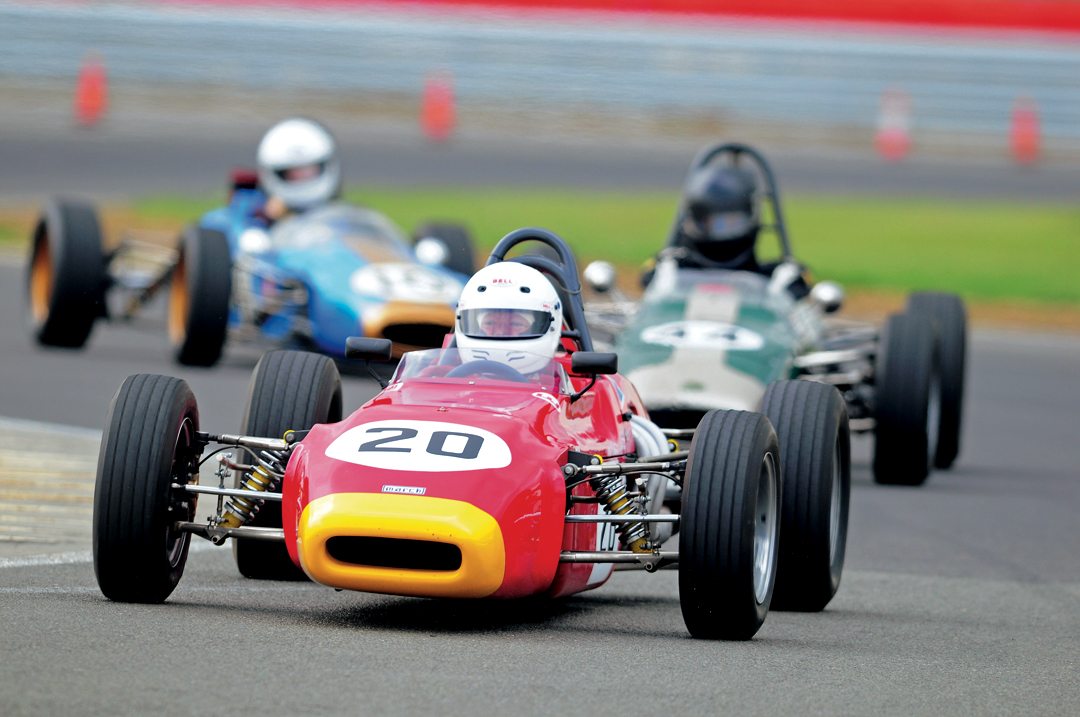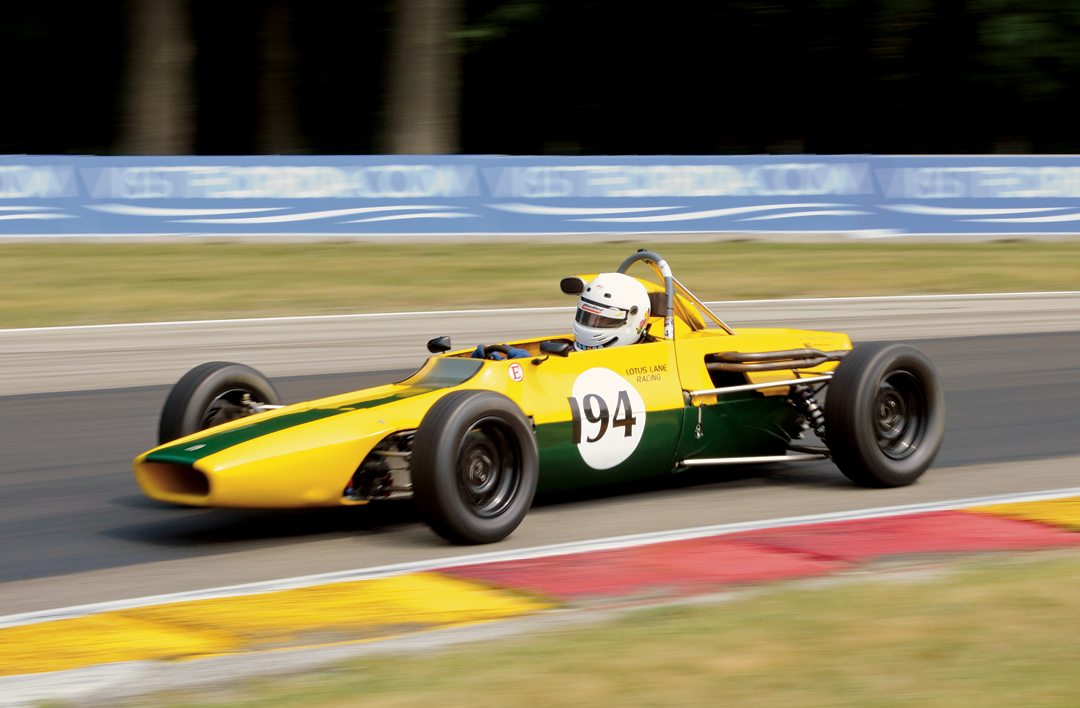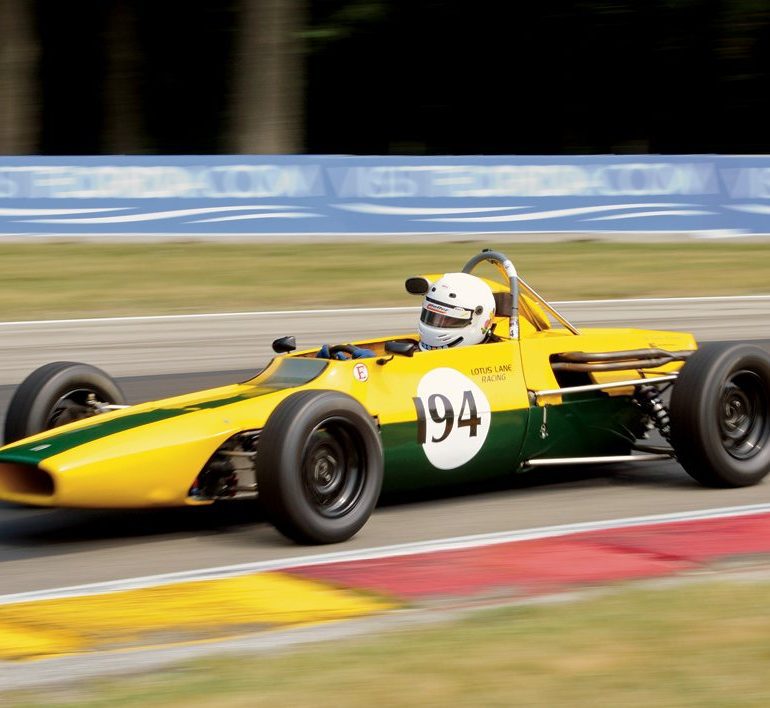Formula Ford was a specification racing series created on the theory that the best drivers would win if they were racing identical cars. The idea for this low-budget Formula was created by an Englishman named Geoffrey Clarke, who had a driver’s school called Motor Racing Stables, based at the Brands Hatch Circuit. Clarke received support from Ford’s competition manager, Henry Taylor, and Ford’s director of public affairs, Walter Hayes. Ford supplied its 1600-cc Cortina GT engine, as well as its backing and name. Lotus Components built a car based on the Lotus 31 Formula Three car, calling it the Lotus 51 Formula Ford. Ironically, this early car had a Renault gearbox. It sold for the affordable price of just under £1,000, making racing in this series very affordable, since an F3 car of the day cost more than £3,000. The Royal Automobile Club, Britain’s governing body, established a set of racing regulations. The first official race was held at Brands Hatch on July 2, 1967. From 1967 to the present, Formula Ford has produced some very exciting racing among many different makes of racing cars, as well as some great drivers and future champions, including Emerson Fittipaldi, Jody Scheckter, Ayrton Senna, Michael Andretti and Tim Schenken. Today, Historic Formula Ford is an entry-level racing category and, for the purposes of this guide, covers cars from 1967 to 1972. Keep in mind, however, that the greatest single factor in determining the value of a Formula Ford is the quality and cost of its preparation.
Make |
Model |
Acceptance |
Level III |
Level II |
Level I |
Change |
Notes |
| Alexis | 14 | 3 | $8,000 | $12,000 | $17,000 | ||
| 15 | 3 | $8,000 | $12,000 | $17,000 | |||
| 18, 18B | 3 | $9,000 | $14,000 | $18,000 | 3 | ||
| 22 | 3 | $9,000 | $14,000 | $19,000 | 3 | ||
| Beach | Mk II | 3 | $7,500 | $15,000 | $21,000 | 3 | |
| Bobsy | 3 | $5,000 | $10,000 | $15,000 | |||
| Caldwell | D9, D9B | 3 | $8,000 | $16,000 | $23,000 | ||
| Crossle | 16F | 3 | $9,000 | $13,000 | $17,000 | 3 | |
| 20F | 3 | $10,000 | $13,000 | $20,000 | 3 | ||
| Dulon | LD4, 4B, 4C | 3 | $5,000 | $10,000 | $15,000 | ||
| LD9 | 3 | $6,000 | $11,000 | $17,000 | |||
| Elden | PH6 | 3 | $5,000 | $11,000 | $17,000 | ||
| PH8 | 3 | $5,000 | $12,000 | $18,000 | |||
| PH10 | 3 | $6,000 | $13,000 | $20,000 | |||
| Elfin | 600 | 3 | $5,000 | $10,000 | $15,000 | 3 | |
| Forsgrini | Mk 12 | 3 | $5,000 | $10,000 | $15,000 | 3 | |
| Ginetta | G-18 | 3 | $7,000 | $12,000 | $17,500 | 3 | |
| Hawke | DL2, 2A, 2B | 3 | $7,500 | $11,000 | $19,000 | ||
| DL9, 9A | 3 | $10,000 | $12,000 | $21,500 | |||
| LeGrand | Mk 10 | 3 | $5,000 | $10,000 | $15,000 | ||
| Lola | T200 | 3 | $6,000 | $11,000 | $18,000 | ||
| T202 | 3 | $6,500 | $12,000 | $20,000 | |||
| T204 | 3 | $7,000 | $13,000 | $21,000 | |||
| Lotus | 51 A,B,C | 3 | $12,000 | $18,000 | $29,500 | ||
| 61M, MX | 3 | $9,000 | $15,000 | $20,000 | |||
| 69 | 3 | $19,000 | $26,500 | $37,000 | | 3 | |
| Macon | MR 7B | 3 | $4,000 | $9,000 | $14,000 | 3 | |
| MR8, 8B | 3 | $5,000 | $10,000 | $15,000 | 3 | ||
| March | 709, 719, 729 | 3 | $10,000 | $14,000 | $21,000 | ||
| McNamara | FFA | 3 | $4,000 | $9,000 | $15,000 | 3 | |
| Merlyn | Mk11, 11A | 3 | $12,000 | $17,000 | $25,000 | ||
| Merlyn | Mk17, 17A | 3 | $10,000 | $15,000 | $20,000 | ||
| Mk20, 20A | 3 | $12,000 | $17,000 | $22,000 | |||
| Mirage | Mk5 | 3 | $5,000 | $9,000 | $15,000 | 3 | |
| Mistrale | 3 | $5,000 | $9,000 | $15,000 | 3 | ||
| Nike | Mk 4, 6, 10 | 3 | $5,000 | $9,000 | $15,000 | 3 | |
| Royale | RP2 | 3 | $5,000 | $10,000 | $17,000 | ||
| RP3, 3A | 3 | $7,500 | $11,000 | $19,000 | |||
| Tecno | FF | 3 | $10,000 | $15,000 | $20,000 | 3 | |
| Titan | Mk 4, 5 | 3 | $10,000 | $15,000 | $20,000 | 3 | |
| Mk 6,6A,6B,6C | 3 | $10,000 | $15,000 | $24,000 | |||
| Winkelman | WDF1,2,3,4 | 3 | $10,000 | $15,000 | $20,000 |
1970 March 708/709

1972 Titan 6B or 1970 Titan Mark 6

The British Titan Racing Car Company was founded in 1968, like Hawke, over a split with Lotus Cars. Charles Lucas, an important Lotus customer, left Colin Chapman to back R.J. “Roy” Thomas and Titan Cars. Thomas had apprenticed at Gemini Cars, building Formula Juniors. Thomas’ shop in Shepherd’s Bush was in an automotive Mecca with interesting neighbors such as a young Frank Williams. First, 12 Titan Mk4s, then 15 Mk5s were built, all selling to one customer, Harvey Snow. In 1970, the Mk6 was a huge success, with much credit going to USA importers Fred Opert and Pierre Phillips—perhaps somewhat ironic considering the name was taken from the U.S. Titan rocket. Titan’s Mk6 won British FF Championships in 1970, ’71 and ’72, and the SCCA National Championship in 1971. Titan also sold race-prepared engines, with its best customer being American Lola importer Carl Haas, who equipped his Lola Formula Fords with Titan Gold Seal engines.
Criteria Used For Assessing Valuations for this Guide:
- Degree of Originality
- Overall Condition, Restoration
- Technology, Design, Coachbuilder
- Production Numbers/Rarity
- Competition History
- Ownership History, Documentation
- Modern Event Eligibility
Regional Variances
The prices stated in this guide are based on U.S. values. The values of historic racing cars can vary as much as 25%-35% in other countries, depending on local market appeal, currency rates, import duties, and VAT. Most of the time, we are able to document known sales or closed escrows, as they say in real estate. When this is not possible, a logical estimate of the car’s value is given, based on its sales history and relationship to cars of its type.
The prices stated in this guide are based on U.S. values. The values of historic racing cars can vary as much as 25%-35% in other countries, depending on local market appeal, currency rates, import duties, and VAT.
LEVEL |
VALUATION CATEGORIES |
|---|---|
I |
The best combination of all criteria. |
II |
Satisfies mid-range of criteria. |
III |
In need of restoration. Meets only a few points of criteria |




